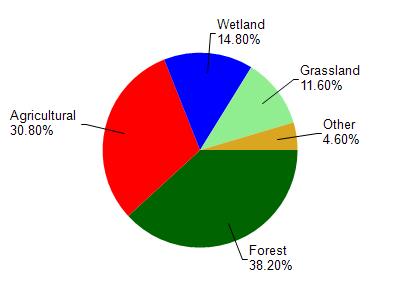Adams
No
No
No
Fish and Aquatic Life
Overview
Mcdougall Lake, in the Neenah Creek Watershed, is a 14.17 acre lake that falls in Adams County. This lake is managed for fishing and swimming and is currently not considered impaired.
Date 2011
Author Aquatic Biologist
Historical Description
This is a clear, slightly alkaline, hard water drainage lake that has a high transparency. It has a man-made lake located on Peppermill Creek and it was constructed as the result of a marl removal operation. The fishery consists of largemouth bass, bluegills, pumpkinseed, rock bass, and bullheads. There is public access from Peppermill Creek. Boats may be rented. There is one dwelling. Marsh furbearers are present and waterfowl may be found during the migratory seasons. Source: 1966, Surface Water Resources of Adams County McDougall Lake, T15N, R7E, Section 11 Surface Acres = 8.5, S.D.F.= 1.96, Maximum Depth = 8 feet
Date 1966
Author Surface Water Inventory Of Wisconsin
Condition
Wisconsin has over 84,000 miles of streams, 15,000 lakes and milllions of acres of wetlands. Assessing the condition of this vast amount of water is challenging. The state's water monitoring program uses a media-based, cross-program approach to analyze water condition. An updated monitoring strategy (2015-2020) is now available. Compliance with Clean Water Act fishable, swimmable standards are located in the Executive Summary of Water Condition in 2018. See also the 'monitoring and projects' tab.
Reports
Recommendations
Lake Classification
Adams County proposes to wrap up its county-wide lake classification effort. Major project elements to include: 1) completion of water sampling, 2) development of lakes classification report and individual lake summaries, 3) development of a powerpoint presentation, 4) four public meetings, 5) expansion of shoreline restoration packet.
Lake Classification
Adams County continue its lake classification efforts through collecting and assessing chemical and biological data on all lakes within the county that afford public access. Major project componants to include: 1) collection and assessment of chemical and biological data, 2) development of a "library" of information for public use, 3) development of management recommendations, 4) I&E for riparians and lake users.
Lake Classification
Adams County proposes to initiate a Lakes Classification effort to assist in comprehensive plan development for communities surrounding its lakes with public access. Phase 1 elements, to be funded with this grant, include: 1) delination of surface watersheds and flow patterns, 2) delineation of ground watersheds, 3) identification and mapping of land uses, 4) inventory and mapping of shoreline erosion and development problems, 5) identification and mapping of sensitive/critical areas and natural heritage habitats, 6) verification of wetland delineations, 7) delineations of lake watersheds, 8) development of lake maps
Management Goals
Wisconsin's Water Quality Standards provide qualitative and quantitative goals for waters that are protective of Fishable, Swimmable conditions [Learn more]. Waters that do not meet water quality standards are considered impaired and restoration actions are planned and carried out until the water is once again fishable and swimmable
Management goals can include creation or implementation of a Total Maximum Daily Load analysis, a Nine Key Element Plan, or other restoration work, education and outreach and more. If specific recommendations exist for this water, they will be displayed below online.
Monitoring
Monitoring the condition of a river, stream, or lake includes gathering physical, chemical, biological, and habitat data. Comprehensive studies often gather all these parameters in great detail, while lighter assessment events will involve sampling physical, chemical and biological data such as macroinvertebrates. Aquatic macroinvertebrates and fish communities integrate watershed or catchment condition, providing great insight into overall ecosystem health. Chemical and habitat parameters tell researchers more about human induced problems including contaminated runoff, point source dischargers, or habitat issues that foster or limit the potential of aquatic communities to thrive in a given area. Wisconsin's Water Monitoring Strategy was recenty updated.
Grants and Management Projects
Monitoring Projects
| WBIC | Official Waterbody Name | Station ID | Station Name | Earliest Fieldwork Date | Latest Fieldwork Date | View Station | View Data |
|---|
| 178500 | McDougall Lake | 10000548 | Mcdougall Lake | 7/27/1999 | 9/22/2017 | Map | Data |
| 178500 | McDougall Lake | 013151 | Mcdougall Lake - Deepest Point | | | Map | Data |
|

Watershed Characteristics
McDougall Lake is located in the Neenah Creek watershed which is 173.35 mi². Land use in the watershed is primarily forest (38.20%), agricultural (30.80%) and a mix of wetland (14.80%) and other uses (16.20%). This watershed has 198.75 stream miles, 2,104.14 lake acres and 14,499.98 wetland acres.
Nonpoint Source Characteristics
This watershed is ranked Not Available for runoff impacts on streams, Not Ranked for runoff impacts on lakes and High for runoff impacts on groundwater and therefore has an overall rank of High. This value can be used in ranking the watershed or individual waterbodies for grant funding under state and county programs.However, all waters are affected by diffuse pollutant sources regardless of initial water quality. Applications for specific runoff projects under state or county grant programs may be pursued. For more information, go to surface water program grants.